
- •Contents
- •Preface
- •Intended Audience
- •About this Guide
- •Typographical Conventions
- •Related Documentation
- •What’s In This Chapter?
- •Chapter Contents
- •What is Data Modeling?
- •Data Modeling Sessions
- •Session Roles
- •Sample IDEF1X Modeling Methodology
- •Logical Models
- •The Entity Relationship Diagram
- •The Key-Based Model
- •The Fully-Attributed (FA) Model
- •Physical Models
- •The Transformation Model
- •The DBMS Model
- •Benefits of Modeling in ERwin
- •What’s In This Chapter?
- •Chapter Contents
- •The Entity-Relationship Diagram
- •Defining Entities and Attributes
- •Logical Relationships
- •Many-to-Many Relationships
- •Validating the Design of the Logical Model
- •Data Model Example
- •What’s In This Chapter?
- •Chapter Contents
- •Understanding Keys
- •Selecting a Primary Key
- •Designating Alternate Key Attributes
- •Inversion Entry Attributes
- •Relationships and Foreign Key Attributes
- •Dependent and Independent Entities
- •Identifying Relationships
- •Non-Identifying Relationships
- •Rolenames
- •What’s In This Chapter?
- •Chapter Contents
- •Naming Entities and Attributes
- •Synonyms, Homonyms and Aliases
- •Entity Definitions
- •Descriptions
- •Business Examples
- •Comments
- •Definition References and Circularity
- •Constructing a Business Glossary
- •Attribute Definitions
- •Rolenames
- •Definitions and Business Rules
- •What’s In This Chapter?
- •Chapter Contents
- •Relationship Cardinality
- •Cardinality in Non-Identifying Relationships
- •Referential Integrity
- •Reading Referential Integrity Options
- •RI, Cardinality, and Identifying Relationships
- •RI, Cardinality, and Non-Identifying Relationships
- •Additional Relationship Types
- •Many-to-Many Relationships
- •N-ary Relationships
- •Recursive Relationships
- •Subtype Relationships
- •Complete Versus Incomplete Subtype Structures
- •Inclusive and Exclusive Relationships
- •IDEF1X and IE Subtype Notation
- •When to Create a Subtype Relationship
- •Introduction
- •Chapter Contents
- •Overview of the Normal Forms
- •Functional Dependence (FD)
- •Full Functional Dependence
- •First Normal Form (1NF)
- •Second Normal Form (2NF)
- •Third Normal Form (3NF)
- •Common Design Problems
- •Repeating Data Groups
- •Multiple Use of the Same Attribute
- •Multiple Occurrences of the Same Fact
- •Conflicting Facts
- •Derived Attributes
- •Missing Information
- •Unification
- •How Much Normalization Is Enough?
- •Conclusions
- •ERwin Support for Normalization
- •First Normal Form Support
- •Second and Third Normal Form Support
- •What’s In This Chapter?
- •Chapter Contents
- •Creating a Physical Model
- •Denormalization
- •Classification of Dependent Entities
- •Glossary of Terms
- •Index
- •Documentation Comments Form
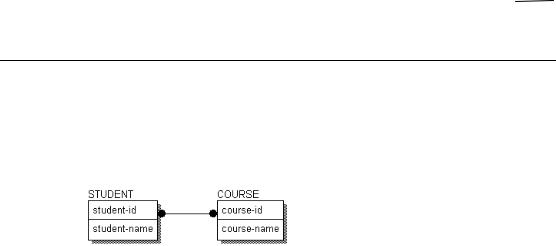
ERwin Methods Guide |
5 |
|
|
Many-to-Many Relationships
In key-based and fully-attributed models, relationships must relate zero or one instances in a parent entity to a specific set of instances in a child entity. As a result of this rule, many-to-many relationships that were dicovered and documented in an ERD or earlier modeling phase must be broken down into a pair of one-to-many relationships.
The example above shows a many-to-many relationship between STUDENTs and COURSEs. If you did not eliminate the many-to-many relationship between COURSE and STUDENT, for example, the key of COURSE would be included in the key of STUDENT, and vice versa. But COURSEs are identified by their own keys, and likewise for STUDENTs -- creating an endless loop!
Refining Model Relationships ∙ 57
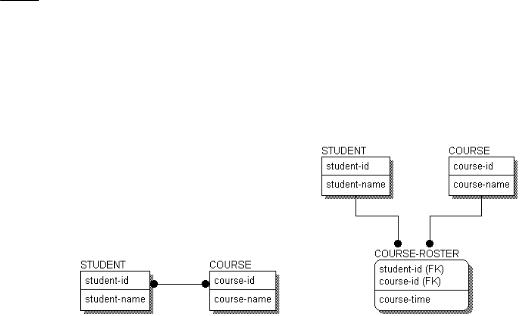
5 |
ERwin Methods Guide |
|
|
You can eliminate the many-to-many relationship by creating an associative entity. In the example below, we have resolved the many-to-many relationship between STUDENT and COURSE by adding COURSE-ROSTER entity.
Resolving the STUDENT-COURSE Relationship Using an Associative Entity
COURSE-ROSTER is an associative entity, meaning it is used to define the association between two related entities.
Many-to-many relationships often hide meaning. In the diagram with a many- to-many relationship, you know that a STUDENT enrolls in many COURSEs, but no information is included to show how. When you resolve the many-to- many relationship, you see not only how the entities are related, but uncover additional information, such as the “course-time,” that also describes facts about the relationship.
Once the many-to-many relationship is resolved, you are faced with the requirement to include relationship verb phrases that validate the structure. There are two ways to do this: construct new verb phrases, or use the verb phrases as they existed for the many-to-many relationship. The most straightforward way is to continue to read the “many-to-many” relationship, through the associative entity. So you can read A STUDENT <enrolls in> many COURSEs and A COURSE <is taken by> many STUDENTs. Many modelers adopt this style for constructing and reading a model.
58 ∙ Refining Model Relationships
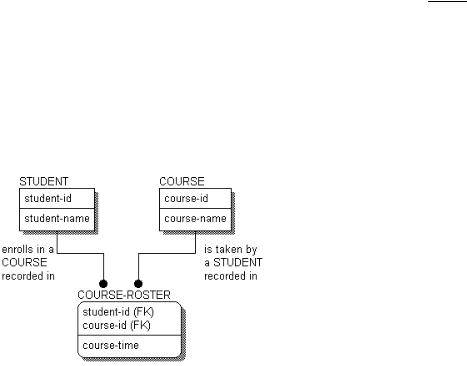
ERwin Methods Guide |
5 |
|
|
There is another style, which is equally correct, but a bit more cumbersome. The structure of the model is exactly the same, but the verb phrases are different, and the model is “read” in a slightly different way. In this example, you would read: A STUDENT <enrolls in a COURSE recorded in> one or more COURSE-ROSTERs, and A COURSE <is taken by a STUDENT recorded in> one or more COURSE-ROSTERs.
Reading Relationships Through Associative Entities
Although the verb phrases have gotten fairly long, the reading follows the standard pattern reading directly from the parent entity to the child.
Whichever style you choose, be consistent. Deciding how to record verb phrases for many-to-many relationships is not too difficult when the structures are fairly simple, as in our examples. However, this can become more difficult when the structures become more complex, such as when the entities on either side of the associative entities are themselves associative entities, which are there to represent other many-to-many relationships.
Refining Model Relationships ∙ 59
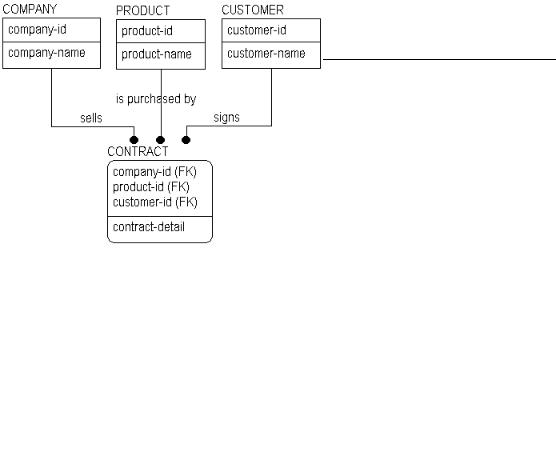
5 |
ERwin Methods Guide |
|
|
N-ary Relationships
When a single parent-child relationship exists, the relationship is called binary. All of the previous examples of relationships to this point have been binary relationships. However, when creating a data model, it is not uncommon to come across n-ary relationships, which are the modeling name for relationships between two or more parent entities and a single child table. An example of an n-ary relationship is shown below.
N-ary Relationship
Like many-to-many relationships, three-, four-, or “n-ary” relationships are valid constructs in entity-relationship diagrams. Also like many-to-many relationships, n-ary relationships should be resolved in later models using a set of binary relationships to an associative entity.
If you consider the business rule stated in the example above, you see that a CONTRACT represents a three-way relationship among COMPANY, PRODUCT, and CUSTOMER. The structure indicates that many COMPANYs sell many PRODUCTs to many CUSTOMERs. When you see a relationship like this, however, you know that there are business questions begging to be asked. For example, “Must a product be offered by a company before it can be sold?” “Can a customer establish a single contract including products from several different companies?” and, “Do we need to keep track of which customers “belong to” which companies?” Depending on the answers, the structures may change.
60 ∙ Refining Model Relationships
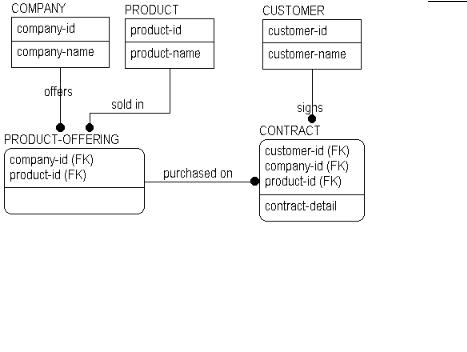
ERwin Methods Guide |
5 |
|
|
If, for example, the answer to the question "Must a product be offered by a company before it can be sold?” is “yes,” then we would have to change the structure as shown below.
Resolving an N-ary Relationship
Because PRODUCTs must be offered by COMPANYs, you can create an associative entity to capture this relationship. As a result, the original “threeway” relationship to CONTRACT is replaced by two, “two-way” relationships.
By asking a variety of business questions, it is likely that you will find that most “n-ary” relationships can be broken down into a series of relationships to associative entities.
Refining Model Relationships ∙ 61
